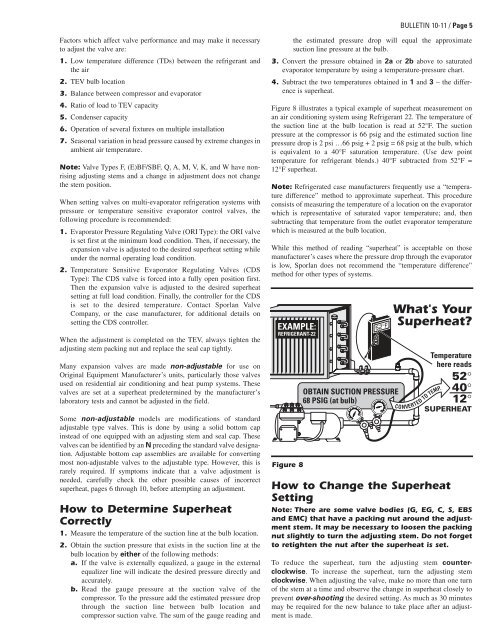Sporlan TXV Inst Se.. - HVAC.Amickracing
Sporlan TXV Inst Se.. - HVAC.Amickracing
Sporlan TXV Inst Se.. - HVAC.Amickracing
Create successful ePaper yourself
Turn your PDF publications into a flip-book with our unique Google optimized e-Paper software.
BULLETIN 10-11 / Page 5Factors which affect valve performance and may make it necessaryto adjust the valve are:1. Low temperature difference (TDs) between the refrigerant andthe air2. TEV bulb location3. Balance between compressor and evaporator4. Ratio of load to TEV capacity5. Condenser capacity6. Operation of several fixtures on multiple installation7. <strong>Se</strong>asonal variation in head pressure caused by extreme changes inambient air temperature.Note: Valve Types F, (E)BF/SBF, Q, A, M, V, K, and W have nonrisingadjusting stems and a change in adjustment does not changethe stem position.When setting valves on multi-evaporator refrigeration systems withpressure or temperature sensitive evaporator control valves, thefollowing procedure is recommended:1. Evaporator Pressure Regulating Valve (ORI Type): the ORI valveis set first at the minimum load condition. Then, if necessary, theexpansion valve is adjusted to the desired superheat setting whileunder the normal operating load condition.2. Temperature <strong>Se</strong>nsitive Evaporator Regulating Valves (CDSType): The CDS valve is forced into a fully open position first.Then the expansion valve is adjusted to the desired superheatsetting at full load condition. Finally, the controller for the CDSis set to the desired temperature. Contact <strong>Sporlan</strong> ValveCompany, or the case manufacturer, for additional details onsetting the CDS controller.When the adjustment is completed on the TEV, always tighten theadjusting stem packing nut and replace the seal cap tightly.Many expansion valves are made non-adjustable for use onOriginal Equipment Manufacturer’s units, particularly those valvesused on residential air conditioning and heat pump systems. Thesevalves are set at a superheat predetermined by the manufacturer’slaboratory tests and cannot be adjusted in the field.Some non-adjustable models are modifications of standardadjustable type valves. This is done by using a solid bottom capinstead of one equipped with an adjusting stem and seal cap. Thesevalves can be identified by an N preceding the standard valve designation.Adjustable bottom cap assemblies are available for convertingmost non-adjustable valves to the adjustable type. However, this israrely required. If symptoms indicate that a valve adjustment isneeded, carefully check the other possible causes of incorrectsuperheat, pages 6 through 10, before attempting an adjustment.How to Determine SuperheatCorrectly1. Measure the temperature of the suction line at the bulb location.2. Obtain the suction pressure that exists in the suction line at thebulb location by either of the following methods:a. If the valve is externally equalized, a gauge in the externalequalizer line will indicate the desired pressure directly andaccurately.b. Read the gauge pressure at the suction valve of thecompressor. To the pressure add the estimated pressure dropthrough the suction line between bulb location andcompressor suction valve. The sum of the gauge reading andthe estimated pressure drop will equal the approximatesuction line pressure at the bulb.3. Convert the pressure obtained in 2a or 2b above to saturatedevaporator temperature by using a temperature-pressure chart.4. Subtract the two temperatures obtained in 1 and 3 – the differenceis superheat.Figure 8 illustrates a typical example of superheat measurement onan air conditioning system using Refrigerant 22. The temperature ofthe suction line at the bulb location is read at 52°F. The suctionpressure at the compressor is 66 psig and the estimated suction linepressure drop is 2 psi …66 psig + 2 psig = 68 psig at the bulb, whichis equivalent to a 40°F saturation temperature. (Use dew pointtemperature for refrigerant blends.) 40°F subtracted from 52°F =12°F superheat.Note: Refrigerated case manufacturers frequently use a “temperaturedifference” method to approximate superheat. This procedureconsists of measuring the temperature of a location on the evaporatorwhich is representative of saturated vapor temperature; and, thensubtracting that temperature from the outlet evaporator temperaturewhich is measured at the bulb location.While this method of reading “superheat” is acceptable on thosemanufacturer’s cases where the pressure drop through the evaporatoris low, <strong>Sporlan</strong> does not recommend the “temperature difference”method for other types of systems.Figure 8OBTAIN SUCTION PRESSURE68 PSIG (at bulb)What's YourSuperheat?Temperaturehere reads52°40°12°SUPERHEATHow to Change the Superheat<strong>Se</strong>ttingNote: There are some valve bodies (G, EG, C, S, EBSand EMC) that have a packing nut around the adjustmentstem. It may be necessary to loosen the packingnut slightly to turn the adjusting stem. Do not forgetto retighten the nut after the superheat is set.To reduce the superheat, turn the adjusting stem counterclockwise.To increase the superheat, turn the adjusting stemclockwise. When adjusting the valve, make no more than one turnof the stem at a time and observe the change in superheat closely toprevent over-shooting the desired setting. As much as 30 minutesmay be required for the new balance to take place after an adjustmentis made.















